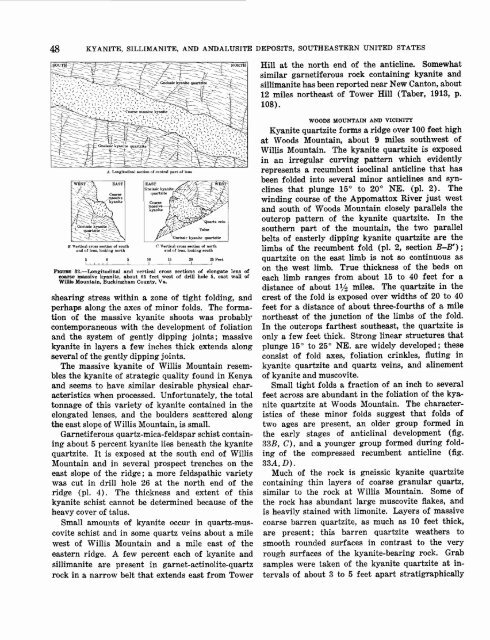Kyanite, Sillimanite, and Andalusite Deposits of the Southeastern ...
Kyanite, Sillimanite, and Andalusite Deposits of the Southeastern ...
Kyanite, Sillimanite, and Andalusite Deposits of the Southeastern ...
Create successful ePaper yourself
Turn your PDF publications into a flip-book with our unique Google optimized e-Paper software.
48 KYANITE, SILLIMANITE, AND ANDALUSITE DEPOSITS, SOUTHEASTERN UNITED STATES<br />
Hill at <strong>the</strong> north end <strong>of</strong> <strong>the</strong> anticline. Somewhat<br />
similar garnetiferous rock containing kyanite <strong>and</strong><br />
sillimanite has been reported near New Canton, about<br />
12 miles nor<strong>the</strong>ast <strong>of</strong> Tower Hill (Taber, 1913, p.<br />
108).<br />
B Vertical cross section <strong>of</strong> south<br />
end <strong>of</strong> lens, looking north<br />
C. Vertical cross section <strong>of</strong> north<br />
end <strong>of</strong> lens, looking south<br />
FIGURE 32. Longitudinal <strong>and</strong> vertical cross sections <strong>of</strong> elongate lens <strong>of</strong><br />
coarse massive kyanite, about 65 feet west <strong>of</strong> drill hole 5, east wall <strong>of</strong><br />
Willis Mountain, Buckingham County, Va.<br />
shearing stress within a zone <strong>of</strong> tight folding, <strong>and</strong><br />
perhaps along <strong>the</strong> axes <strong>of</strong> minor folds. The formation<br />
<strong>of</strong> <strong>the</strong> massive kyanite shoots was probably<br />
contemporaneous with <strong>the</strong> development <strong>of</strong> foliation<br />
<strong>and</strong> <strong>the</strong> system <strong>of</strong> gently dipping joints; massive<br />
kyanite in layers a few inches thick extends along<br />
several <strong>of</strong> <strong>the</strong> gently dipping joints.<br />
The massive kyanite <strong>of</strong> Willis Mountain resembles<br />
<strong>the</strong> kyanite <strong>of</strong> strategic quality found in Kenya<br />
<strong>and</strong> seems to have similar desirable physical characteristics<br />
when processed. Unfortunately, <strong>the</strong> total<br />
tonnage <strong>of</strong> this variety <strong>of</strong> kyanite contained in <strong>the</strong><br />
elongated lenses, <strong>and</strong> <strong>the</strong> boulders scattered along<br />
<strong>the</strong> east slope <strong>of</strong> Willis Mountain, is small.<br />
Garnetiferous quartz-mica-feldspar schist containing<br />
about 5 percent kyanite lies beneath <strong>the</strong> kyanite<br />
quartzite. It is exposed at <strong>the</strong> south end <strong>of</strong> Willis<br />
Mountain <strong>and</strong> in several prospect trenches on <strong>the</strong><br />
east slope <strong>of</strong> <strong>the</strong> ridge; a more feldspathic variety<br />
was cut in drill hole 26 at <strong>the</strong> north end <strong>of</strong> <strong>the</strong><br />
ridge (pi. 4). The thickness <strong>and</strong> extent <strong>of</strong> this<br />
kyanite schist cannot be determined because <strong>of</strong> <strong>the</strong><br />
heavy cover <strong>of</strong> talus.<br />
Small amounts <strong>of</strong> kyanite occur in quartz-muscovite<br />
schist <strong>and</strong> in some quartz veins about a mile<br />
west <strong>of</strong> Willis Mountain <strong>and</strong> a mile east <strong>of</strong> <strong>the</strong><br />
eastern ridge. A few percent each <strong>of</strong> kyanite <strong>and</strong><br />
sillimanite are present in garnet-actinolite-quartz<br />
rock in a narrow belt that extends east from Tower<br />
WOODS MOUNTAIN AND VICINITY<br />
<strong>Kyanite</strong> quartzite forms a ridge over 100 feet high<br />
at Woods Mountain, about 9 miles southwest <strong>of</strong><br />
Willis Mountain. The kyanite quartzite is exposed<br />
in an irregular curving pattern which evidently<br />
represents a recumbent isoclinal anticline that has<br />
been folded into several minor anticlines <strong>and</strong> synclines<br />
that plunge 15° to 20° NE. (pi. 2). The<br />
winding course <strong>of</strong> <strong>the</strong> Appomattox River just west<br />
<strong>and</strong> south <strong>of</strong> Woods Mountain closely parallels <strong>the</strong><br />
outcrop pattern <strong>of</strong> <strong>the</strong> kyanite quartzite. In <strong>the</strong><br />
sou<strong>the</strong>rn part <strong>of</strong> <strong>the</strong> mountain, <strong>the</strong> two parallel<br />
belts <strong>of</strong> easterly dipping kyanite quartzite are <strong>the</strong><br />
limbs <strong>of</strong> <strong>the</strong> recumbent fold (pi. 2, section B-B') ;<br />
quartzite on <strong>the</strong> east limb is not so continuous as<br />
on <strong>the</strong> west limb. True thickness <strong>of</strong> <strong>the</strong> beds on<br />
each limb ranges from about 15 to 40 feet for a<br />
distance <strong>of</strong> about l 1/^ miles. The quartzite in <strong>the</strong><br />
crest <strong>of</strong> <strong>the</strong> fold is exposed over widths <strong>of</strong> 20 to 40<br />
feet for a distance <strong>of</strong> about three-fourths <strong>of</strong> a mile<br />
nor<strong>the</strong>ast <strong>of</strong> <strong>the</strong> junction <strong>of</strong> <strong>the</strong> limbs <strong>of</strong> <strong>the</strong> fold.<br />
In <strong>the</strong> outcrops far<strong>the</strong>st sou<strong>the</strong>ast, <strong>the</strong> quartzite is<br />
only a few feet thick. Strong linear structures that<br />
plunge 15° to 25° NE. are widely developed; <strong>the</strong>se<br />
consist <strong>of</strong> fold axes, foliation crinkles, fluting in<br />
kyanite quartzite <strong>and</strong> quartz veins, <strong>and</strong> alinement<br />
<strong>of</strong> kyanite <strong>and</strong> muscovite.<br />
Small tight folds a fraction <strong>of</strong> an inch to several<br />
feet across are abundant in <strong>the</strong> foliation <strong>of</strong> <strong>the</strong> kyanite<br />
quartzite at Woods Mountain. The characteristics<br />
<strong>of</strong> <strong>the</strong>se minor folds suggest that folds <strong>of</strong><br />
two ages are present, an older group formed in<br />
<strong>the</strong> early stages <strong>of</strong> anticlinal development (fig.<br />
33#, C), <strong>and</strong> a younger group formed during folding<br />
<strong>of</strong> <strong>the</strong> compressed recumbent anticline (fig.<br />
33A,Z>).<br />
Much <strong>of</strong> <strong>the</strong> rock is gneissic kyanite quartzite<br />
containing thin layers <strong>of</strong> coarse granular quartz,<br />
similar to <strong>the</strong> rock at Willis Mountain. Some <strong>of</strong><br />
<strong>the</strong> rock has abundant large muscovite flakes, <strong>and</strong><br />
is heavily stained with limonite. Layers <strong>of</strong> massive<br />
coarse barren quartzite, as much as 10 feet thick,<br />
are present; this barren quartzite wea<strong>the</strong>rs to<br />
smooth rounded surfaces in contrast to <strong>the</strong> very<br />
rough surfaces <strong>of</strong> <strong>the</strong> kyanite-bearing rock. Grab<br />
samples were taken <strong>of</strong> <strong>the</strong> kyanite quartzite at intervals<br />
<strong>of</strong> about 3 to 5 feet apart stratigraphically
















